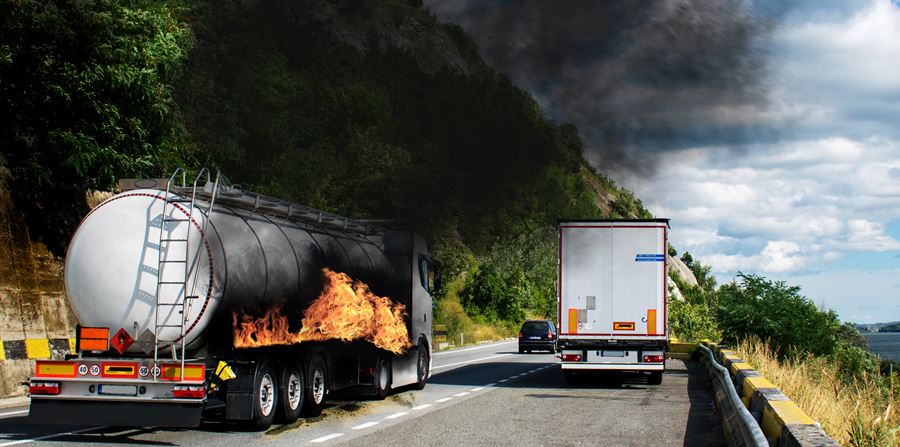The Causes and Investigation of Heavy Equipment Trucking Fires

Across the United States, vehicle fires occur daily. Passenger vehicles, heavy commercial trucks, and heavy construction equipment all have the necessary fuels and ignition sources available to cause a fire. Finding the origin and cause of the fire becomes the pivot point in determining what fuel and ignition sources are in proximity to one another to have caused the fire. Strict adherence to procedures in NFPA 921, Guide for Fire and Explosion Investigations, demonstrates how to narrow the field of burn to a small area in order to determine the origin.
The U.S. Fire Administration finds that one in eight fire department responses are to highway vehicle fires.1 Although, this stat accounts for all vehicles, many of these calls are specifically for heavy equipment trucking fires. The leading cause of these fires is due to mechanical or design flaws which may originate from electrical wiring, fuel, or several other forms of material that can ignite in vehicles fires. Adjusters and attorneys often need to consider the possibility of subrogation if the fire seems suspicious, the vehicle is newer, or other similar vehicles have been catching fire. Fire investigation experts are called on scene to determine the origin and cause, as well as determine liability.
Vehicle Examination & Fire Investigation
The examination of a vehicle fire loss is tedious and complex and sometimes can take longer than a residential house fire. Given the complexity of a vehicle fire, the first and most important step in the investigation of a vehicle fire is to determine the fire's area of origin.
Vehicle fires are similar to structure fires in that the investigator works from the area of least damage to the greatest damage. Heat patterns can give clues to where the fire may have begun. The hottest burn is not necessarily always the origin of the fire, but it helps to determine if the fuel source came later or if it was where the flame started.
To begin this process, the investigation of vehicles can be divided into three sections, the engine compartment, the passenger/driver area, and the cargo space. It is important to investigate all parts in order to determine the heat source, fuel burned, and oxygen availability because together, that chemical reaction creates fire.
Leading Heat Sources of Vehicle Fires
Electrical wiring and fuel are the leading forms of material ignited in vehicle fires but just about every part of a vehicle can burn. Heat sources can come from various parts of a truck's engine or electrical components. These sources include:
- Air compressors, exhaust pipes, or A/C compressors, which get extremely hot to the point of igniting fluids nearby.
- Catalytic converters and regen systems, which can get up to 1,000oF
- Electrical system faults that produce a heating event and can cause other materials to combust.
- Cigarettes, phone chargers, Bluetooth mods, and other common products can also ignite fires.
Common Fuel Sources of Vehicle Fires
Inside a vehicle, there are many components within the three main fuel groups that can cause or spread fire, solids, liquids, and gases.
1. Solids
Solids to investigate can include flame retardant cab components, for example, dash covers, steering wheels, or seats. However, these components are difficult to start on fire but that does not mean they will not burn. Rubber vehicle components, i.e. tires, trim, seals, will burn if you get them hot enough. Metals, surprisingly, can be ignited. Metal components do not melt but consume fire and get extremely hot.
2. Liquids
Liquids of heavy equipment trucks include gasoline, oil and anti-freeze. These and other fluids such as brake fluid, grease, wiper fluid, hydraulic fluid, are all things that will burn easily and quickly. Amazingly enough, anti-freeze will burn if you get it hot enough to boil off the water.
3. Gases
The heating effect of an open flame can vaporize some solids and fluids in a vehicle and turn them into a gas. For example, gasoline, diesel, engine oil, transmission fluid, and brake fluid are all fluids that can be vaporized. On the other hand, pyrolyzed solids are something that can become gasified, where you can see the gases burning off (similar to a fire pit or woodstove).
Opportunities for Subrogation: Case Study
Based on the situation, there can be great opportunity for subrogation. Envista investigated a fire on a Kirby Loader, a livestock feeding truck. During the inspection, the expert observed flame patterns, mass loss, and arcing/beading of electrical circuits and determined glass dropped at the bottom edge of the windshield, inside the cab. The fire investigation expert checked the tires, brakes, wheel bearings, compressors, and turbos – all the clues to determine origin and cause.
Once the point of origin was determined, the investigator found the engine electrical ground cable that connects the engine block with the starter was misrouted. It was configured in a way that caused chafing against the starter's positive battery cables, otherwise known as an electrical short. It was determined that this is what resulted in the vehicle fire. In this case, subrogation would be available because of the faulty electrical wiring.
Unfortunately, the vehicle was previously used and was retrofitted with a Kirby Loader. Since there was no ASE-trained mechanic or Kirby dealer involved, the subrogation was void. However, this case is not a rare one. Electric shorts happen all the time and making sure evidence is collected properly and timely with valid and succinct arguments can help courts make final decisions in subrogation.
There are many variables to consider when investigating a vehicle fire. Manufacturers and vehicle operators with faulty components, deferred maintenance, abuse of machinery, and even misplacement of machinery in a wrong or uncontrolled environment during use can all contribute to fires. All of these factors and many more can be considered, sifted through, and narrowed down using the techniques and fire and explosion investigation guidelines of NFPA 921.
1 https://www.usfa.fema.gov/downloads/pdf/statistics/v19i2.pdf
Our experts are ready to help.
